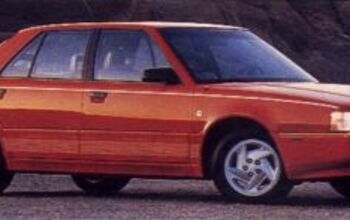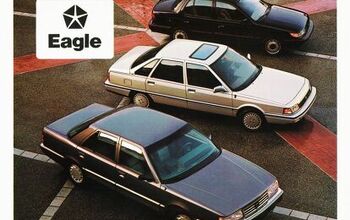Rare Rides: The Eagle Premier Story, Part II

Part I of The Eagle Premier Story covered the inception of the collaborative AMC-Renault X-58 project in 1982, and its front-drive full-size flagship goal. It was to be an all-new car to lead AMC’s North American offerings. In today’s installment, we’ll take a look at the stylish sedan’s technical details more closely.
And a stylish four-door it was, though not groundbreaking. Legendary designer Giorgetto Giugiaro went with an expected three-box design that was angular at the ends, smooth along the sides, with minimal trim fripperies and very limited chrome. The headline image is the finalized work from Italdesign circa 1987. Unusual for a domestic car, the Premier proudly featured Italdesign Giugiaro badges along its door trim. The sleek shape earned it a drag coefficient of 0.31, which nearly matched the revolutionary Audi 100 (5000) coefficient of 0.29. Speaking of which the cars were similar looking in overall shape, and everyone noticed at the time.
When it went on sale, AMC included an extensive seven-year, 100,000-mile corrosion warranty on that Italian-penned body. The warranty wasn’t the only place where the Premier led its competition. It had brighter headlamps than most cars in its class, a new composite design. The lamps themselves were notable, as they were designed by a company called Valeo. Valeo invented a new complex surface reflector design. Only two cars used this new advanced tech, the Premier and the Citroën XM.
Premier was larger inside than any of its rivals, and AMC implemented the space-efficient design drawn by Dick Teague. Trunk passengers enjoyed a large 16.3 cubic feet of space, excellent for the class. The Premier’s interior was very forward-looking for the mid-Eighties and included plenty of electronic goodies. Standard-looking gauges were paired with lighting and climate controls on pods behind the steering wheel. The unusual setup gave full control to the driver and presented the passenger with access to only the glove box, stereo, and the digital stereo equalizer.
In trims without a console shifter, the shift lever was mounted to the pod on the right instead of the steering column, and sunk into the back of it when the car was placed in drive. Very advanced for the time (and probably annoying), turn signal indicators returned to the neutral position immediately when activated, and the driver heard a noise after completing a turn which indicated the signal was no longer active. Wipers had the expected intermittent function, as well as an automatic speed mode which adjusted itself based upon the quantity of water striking the windshield.
AMC chose not to use any Renault 25 engines in the Premier, as all of them were four-cylinder and from Renault. Instead, base models used a 2.5-liter mill from AMC. The engine was nothing new and was used in the AMC Eagle in 1983, after which it moved into Jeep Cherokee duty. The 2.5 used throttle-body injection and managed just 111 horses. Four-cylinder power was used exclusively in the base LX trim Premier.
Customers who felt spendy could option the larger 3.0-liter V6 on the LX, or step up to the top ES trim where it was standard. Said V6 was the PRV V6 of unfortunate acclaim, and variants of it infected many cars. Between 1974 and 1998 the engine was used in sedans, hatchbacks, and vans of various marques, as well as the DeLorean. The V6 at least had fuel injection and made a much more impressive 150 horsepower. Fuel economy was okay at 18 city and 22 highway, but certainly not standout. The V6 Premier took 10 seconds to reach 60, the inline-four took 11.5. All Premiers used a four-speed ZF automatic that was shared with cars like the Renault 25, Audi 100, Saab 9000, and the Porsche 968.
The Premier was technically ready to go at this point, and it was also technically running pretty late. In Part III we’ll discuss what happened when it finally went on sale.
[Images: Italdesign, AMC]

Interested in lots of cars and their various historical contexts. Started writing articles for TTAC in late 2016, when my first posts were QOTDs. From there I started a few new series like Rare Rides, Buy/Drive/Burn, Abandoned History, and most recently Rare Rides Icons. Operating from a home base in Cincinnati, Ohio, a relative auto journalist dead zone. Many of my articles are prompted by something I'll see on social media that sparks my interest and causes me to research. Finding articles and information from the early days of the internet and beyond that covers the little details lost to time: trim packages, color and wheel choices, interior fabrics. Beyond those, I'm fascinated by automotive industry experiments, both failures and successes. Lately I've taken an interest in AI, and generating "what if" type images for car models long dead. Reincarnating a modern Toyota Paseo, Lincoln Mark IX, or Isuzu Trooper through a text prompt is fun. Fun to post them on Twitter too, and watch people overreact. To that end, the social media I use most is Twitter, @CoreyLewis86. I also contribute pieces for Forbes Wheels and Forbes Home.
More by Corey Lewis
Latest Car Reviews
Read moreLatest Product Reviews
Read moreRecent Comments
- ChristianWimmer This would be pretty cool - if it kept the cool front end of the standard/AMG G-Class models. The front ends of current Mercedes’ EVs just look lame.
- Master Baiter The new Model 3 Performance is actually tempting, in spite of the crappy ergonomics. 0-60 in under 3 seconds, which is faster than a C8 Corvette, plus it has a back seat and two trunks. And comparable in weight to a BMW M3.
- SCE to AUX The Commies have landed.
- Arthur Dailey The longest we have ever kept a car was 13 years for a Kia Rondo. Only ever had to perform routine 'wear and tear' maintenance. Brake jobs, tire replacements, fluids replacements (per mfg specs), battery replacement, etc. All in all it was an entirely positive ownership experience. The worst ownership experiences from oldest to newest were Ford, Chrysler and Hyundai.Neutral regarding GM, Honda, Nissan (two good, one not so good) and VW (3 good and 1 terrible). Experiences with other manufacturers were all too short to objectively comment on.
- MaintenanceCosts Two-speed transfer case and lockable differentials are essential for getting over the curb in Beverly Hills to park on the sidewalk.





































Comments
Join the conversation
Ugh. What are your gripes with the PRV? Have you ever owned or driven a car with one? It's perfectly adequate in my '87 Peugeot 505STX. Hating on the PRV is such a tired auto-journalist trope.
Speaking of DeLorean, this three-part series is worthwhile if you are at all interested in the process of bringing a new vehicle to market: https://www.netflix.com/title/80219915 TL;DR: It is not easy to successfully bring a new vehicle to market (and gets progressively more difficult with a new company, new workforce, new technology, et al.). [Little-known fact: Most companies operating in the Real World have various constraints imposed on them - constraints which are very real, but easily ignored by automotive journalists.]